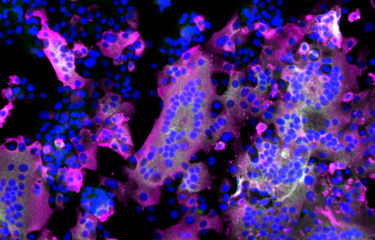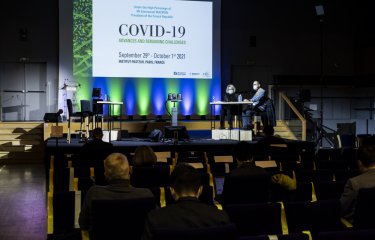Although the mechanisms by which SARS-CoV-2 enters host cells are increasingly well documented, the direct molecular interactions between virus and host remain poorly understood. Scientists from the Institut Pasteur, the French National Center for Scientific Research (CNRS), Université Paris Cité, the Institute of Network Biology (INET) Helmholtz Munich, the Donnelly Center for Cellular and Biomolecular Research in Toronto and the Center for Cancer Systems Biology in Boston have generated a systematic map of the molecular contacts between the SARS-CoV-2 virus and its human host. The identification of direct partners of viral proteins revealed chains of connections between viral and human proteins whose genetic differences could determine the severity of COVID-19 symptoms. These results were published in the journal Nature Biotechnology on October 10, 2022.
The host immune response and each step of the viral cycle are mediated by direct contacts between viral and host molecules. The vast majority of contacts between SARS-CoV-2 and human cells has not yet been identified.
An international team of researchers has generated a systematic map of direct contacts between viral and human proteins, referred to as "contactome". Over 200 direct protein-protein contacts were identified, providing the first comprehensive mapping of the SARS-CoV-2 contactome in humans.
To achieve this, the scientists systematically examined the interactions of around 30 viral proteins, each with ~17,500 human proteins, interrogating 450,000 protein pairs. Charting the contact map was at times like solving a huge puzzle, and required the use of robotics to interrogate such a large number of protein pairs at high throughput, and artificial intelligence methods did the initial evaluation of whether interactions occurred or not.
The scientists were thus able to trace connections between certain SARS-CoV-2 proteins and human proteins encoded by genes that have been linked to an increased likelihood of severe COVID-19 or the presence of certain diseases such as cardiac or metabolic disorders like diabetes. "We already know that genetic differences in humans have an important role in the course and severity of a COVID-19 infection," says Professor Pascal Falter-Braun, who is the co-last author of the paper and Director of the Institute of Network Biology (INET) at Helmholtz Munich. "Thanks to identification of the molecular contact points, it is now possible to examine the underlying mechanisms," he adds.
The researchers then followed up their work with a functional analysis of these proteins. They demonstrated that important inflammatory signaling pathways are directly activated by the virus through direct interaction with certain host proteins. These contacts may help explain the exaggerated inflammatory reaction that plays a major role in progression to the severe form of COVID-19.
"Our expertise in virus-host interactomics combined with the biology of RNA viruses, enabled us to assess the dependence of the virus on specific human proteins," says Caroline Demeret, leader of the Interactomics Group in the Molecular Genetics of RNA Viruses Unit (Institut Pasteur/CNRS/Université Paris Cité) at the Institut Pasteur, and co-last author of the study.
The team developed human cell lines deleted for genes encoding proteins to which SARS-CoV-2 proteins bind. The scientists observed that of the 8 genes tested, the deletion of 5 genes caused a significant reduction in viral replication, which supports their functional relevance. Of these genes, the one that encodes the USP25 protein has been of particular interest to scientists. "The use of a molecule that blocks USP25 in human cells greatly reduces viral replication," says Caroline Demeret. "This opens up possibilities in terms of anti-viral therapy. We are planning research into molecules that block this interaction, which would pave the way for more targeted therapeutic approaches," she adds.
The scientists also observed that the direct interactions differed between SARS-CoV-2 strains. These data suggest a degree of plasticity in the SARS-CoV-2 contactome with human proteins. "Analyzing these interactions across SARS-CoV-2 variants could help determine the risk posed by emerging variants," says Caroline Demeret.
The mapping of direct contacts between viral and human proteins, referred to as "contactome," will serve as a platform for the scientific community to study individual interactions in more detail and to understand their impact on molecular mechanisms and clinical progression, and thus uncover starting points for new therapeutic possibilities
Source :
A proteome-scale map of the SARS-CoV-2–human contactome, Nature Biotechnology, 10 octobre 2022
Dae-Kyum Kim1,2,3,4,5,25, Benjamin Weller 6,25, Chung-Wen Lin6,25, Dayag Sheykhkarimli 1,2,3,4,25, Jennifer J. Knapp 1,2,3,4,25,Guillaume Dugied 7,8,9,25, Andreas Zanzoni 10, Carles Pons11, Marie J. Tofaute 12, Sibusiso B. Maseko13, Kerstin Spirohn 4,14,15 , Florent Laval 4,13,14,15,16,17, Luke Lambourne 4,14,15, Nishka Kishore1,2,3,4, Ashyad Rayhan1,2,3,4, Mayra Sauer6, Veronika Young 6, Hridi Halder6, Nora Marín-de la Rosa6, Oxana Pogoutse1,2,3,4, Alexandra Strobel6,Patrick Schwehn6, Roujia Li1,2,3,4, Simin T. Rothballer6, Melina Altmann6, Patricia Cassonnet7,8,9, Atina G. Coté1,2,3,4, Lena Elorduy Vergara6, Isaiah Hazelwood1,2,3,4, Betty B. Liu1,2,3,4, Maria Nguyen1,2,3,4, Ramakrishnan Pandiarajan6, Bushra Dohai6, Patricia A. Rodriguez Coloma6, Juline Poirson 1,2,18, Paolo Giuliana 1,2,3,4, Luc Willems16,17, Mikko Taipale 1,2,13, Yves Jacob 7,8,9, Tong Hao 4,14,15, David E. Hill 4,14,15,26, Christine Brun 10,19,26, Jean-Claude Twizere4,13,16,26, Daniel Krappmann 12,26, Matthias Heinig20,21,26, Claudia Falter6,26, Patrick Aloy11,22,26, Caroline Demeret7,8,9,26 , Marc Vidal4,14,26 , Michael A. Calderwood 4,14,15,26 , Frederick P. Roth 1,2,3,4,23,26 and Pascal Falter-Braun 6,24,26
1 Donnelly Centre for Cellular and Biomolecular Research (CCBR), University of Toronto, Toronto, Ontario, Canada.
2 Department of Molecular Genetics, University of Toronto, Toronto, Ontario, Canada.
3 Lunenfeld-Tanenbaum Research Institute (LTRI), Sinai Health System, Toronto, Ontario, Canada.
4 Center for Cancer Systems Biology (CCSB), Dana-Farber Cancer Institute, Boston, MA, USA.
5 Department of Cancer Genetics and Genomics, Roswell Park Comprehensive Cancer Center, Buffalo, NY, USA.
6 Institute of Network Biology (INET), Molecular Targets and Therapeutics Center (MTTC), Helmholtz Zentrum München, German Research Center for Environmental Health, Munich-Neuherberg, Germany.
7 Unité de Génétique Moléculaire des Virus à ARN, Département de Virologie, Institut Pasteur, Paris, France.
8 UMR3569, Centre National de la Recherche Scientifique, Paris, France.
9 Université de Paris, Paris, France.
10 Aix-Marseille Université, Inserm, TAGC, Marseille, France.
11 Institute for Research in Biomedicine (IRB Barcelona), Barcelona Institute for Science and Technology, Barcelona, Spain.
12 Research Unit Cellular Signal Integration, Institute of Molecular Toxicology and Pharmacology, Molecular
Targets and Therapeutics Center (MTTC), Helmholtz Zentrum München, German Research Center for Environmental Health, Munich-Neuherberg,Germany.
13 Laboratory of Viral Interactomes, GIGA Institute, University of Liège, Liège, Belgium.
14 Department of Genetics, Blavatnik Institute, Harvard Medical School, Boston, MA, USA. 15 Department of Cancer Biology, Dana-Farber Cancer Institute, Boston, MA, USA.
16 TERRA Teaching and Research Centre, University of Liège, Gembloux, Belgium.
17 Laboratory of Molecular and Cellular Epigenetics, GIGA Institute, University of Liège, Liège, Belgium.
18 Molecular Architecture of Life Program, Canadian Institute for Advanced Research (CIFAR), Toronto, ON, Canada.
19 CNRS, Marseille, France.
20 Institute of Computational Biology (ICB), Computational Health Center, Helmholtz Zentrum München, German Research Center for Environmental Health, Munich-Neuherberg, Germany.
21 Department of Informatics, Technische Universität München, Munich, Germany.
22 Institució Catalana de Recerca I Estudis Avaçats (ICREA), Barcelona, Spain.
23 Department of Computer Science, University of Toronto, Toronto, Ontario, Canada.
24 Microbe-Host Interactions, Faculty of Biology, Ludwig-Maximilians-Universität (LMU) München, Planegg-Martinsried, Germany.
25 These authors contributed equally: Dae-Kyum Kim, Benjamin Weller, Chung-Wen Lin, Dayag Sheykhkarimli, Jennifer J. Knapp, Guillaume Dugied.
26 These authors jointly supervised this work: David E. Hill, Christine Brun, Jean-Claude Twizere, Daniel Krappmann, Matthias Heinig, Claudia Falter, Patrick Aloy, Caroline Demeret,Marc Vidal, Michael A. Calderwood, Frederick P. Roth, Pascal Falter-Braun
https://doi.org/10.1038/s41587-022-01475-z





